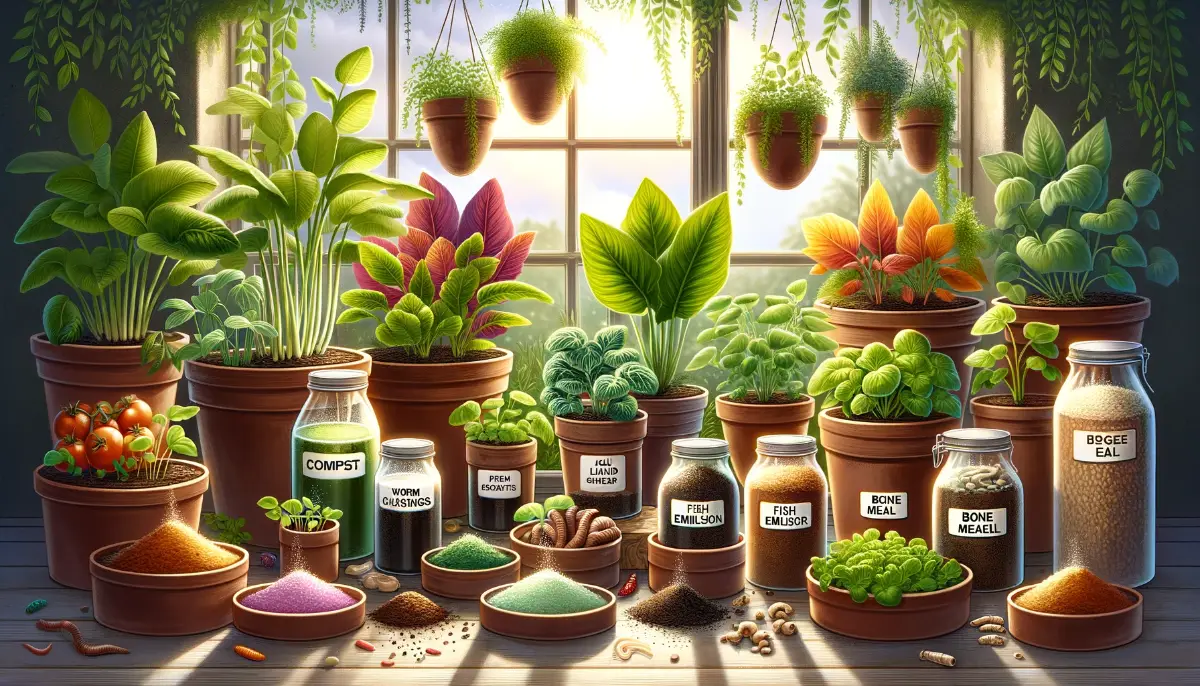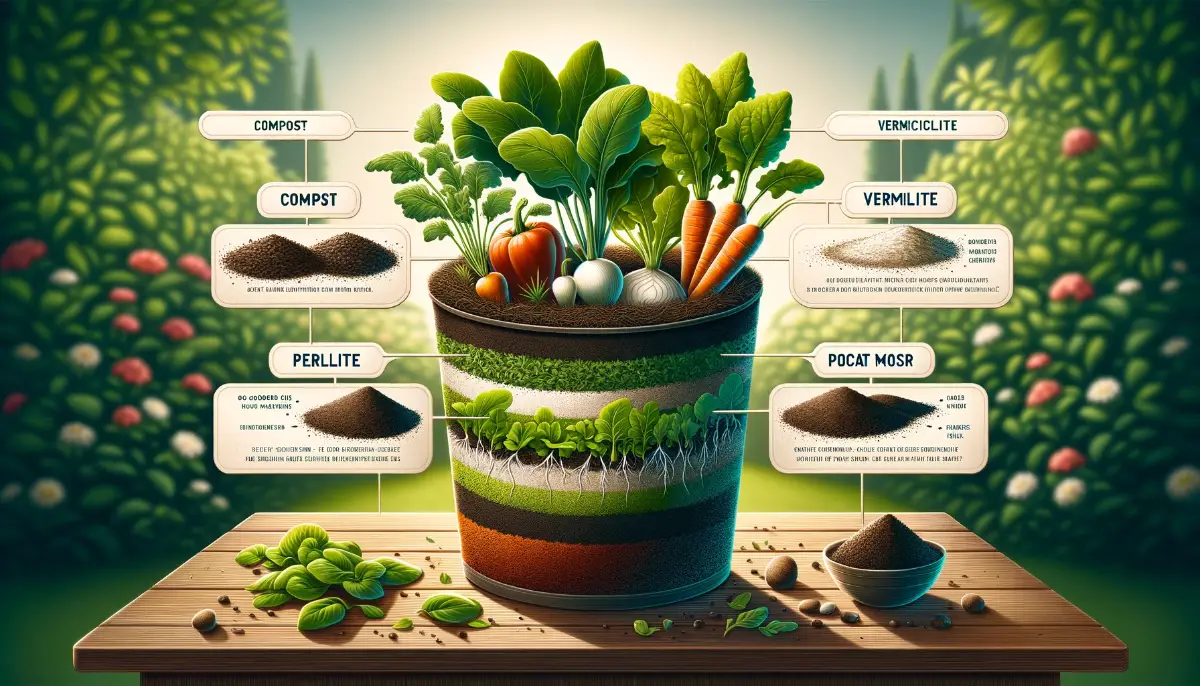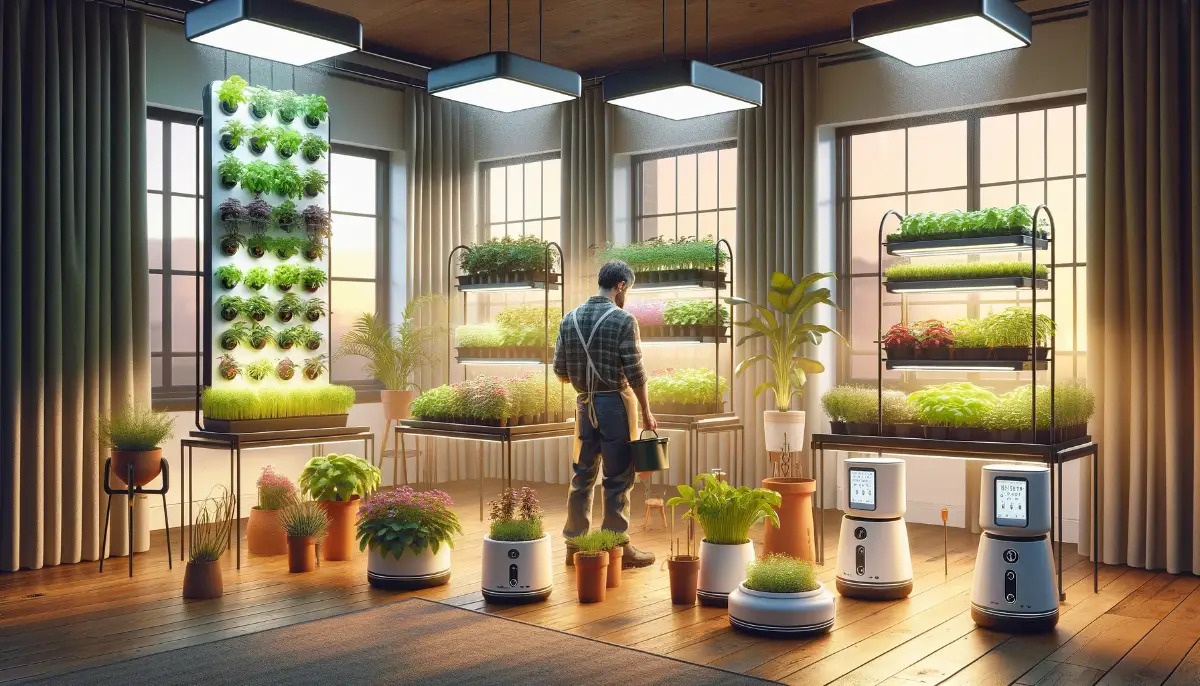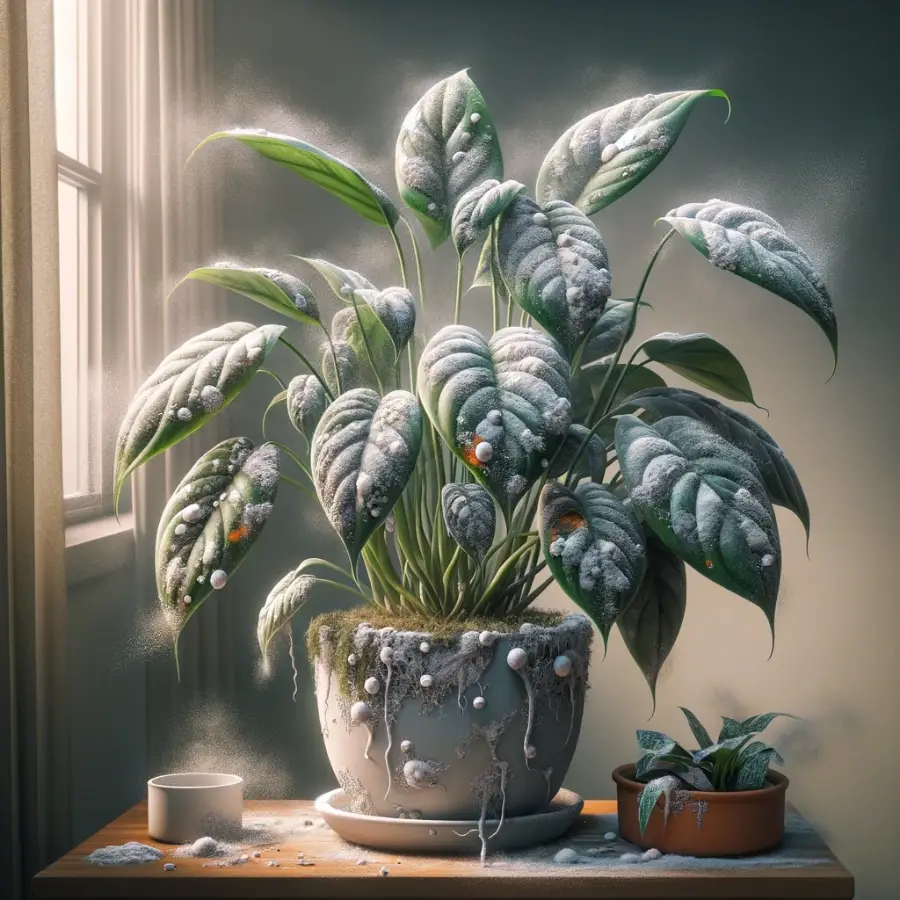Growing cucumbers indoors can be a delightful and fruitful endeavor, allowing you to enjoy fresh, crisp cucumbers year-round, regardless of the outdoor climate.
This article provides comprehensive guidance to help you cultivate cucumbers inside your home, ensuring a bountiful harvest with the right techniques.
How to Get Started with Indoor Cucumbers
Choosing the Right Varieties for Indoor Cultivation
Selecting cucumber varieties that are well-suited for indoor environments is crucial for success. Opt for compact or bush types, like the ‘Bush Crop’ or ‘Salad Bush,’ which are designed for limited space and do not require extensive trellising. Additionally, parthenocarpic varieties, which don’t require pollination, such as ‘Sweet Success’ and ‘Bush Champion,’ are excellent for indoor setups where natural pollinators are absent.
Seed Starting Indoors
Containers and Soil: Begin with pots or seed trays that are at least 2-3 inches deep and ensure they have proper drainage. Use a high-quality, organic potting mix to fill your containers, as this will provide the best start for your cucumber seeds.
Planting Depth and Spacing: Cucumber seeds should be sown at a depth of approximately 1 inch. This depth ensures optimal moisture access and supports healthy germination. Space the seeds about 1-2 inches apart in your container.
Light and Temperature: After planting, position your containers in a spot that receives ample light. Ideally, cucumber seeds need warmth to germinate effectively, so maintaining a temperature between 70-85°F (21-29°C) is vital. If natural light is insufficient, consider using grow lights to provide more than 10 hours of direct light in the early stages of growth.
Lighting Requirements for Growing Cucumbers Indoors
Cucumbers are sun-loving plants that thrive under ample light. For indoor cultivation, ensure your plants receive at least 10-12 hours of light daily. A south-facing window can be ideal, but in its absence, full-spectrum grow lights can compensate for the lack of natural sunlight. Adjust the duration of artificial light as the plant grows, ensuring it does not receive less than 6-7 hours of light to avoid affecting the harvest negatively.
Temperature and Humidity Control
The ideal temperature range for growing cucumbers indoors is between 65-75°F (18-24°C), which typically aligns with comfortable indoor conditions. However, humidity plays a crucial role in cucumber health, with daytime levels best kept between 60-70% and slightly higher at night.
Using a humidifier can help maintain these levels, especially in drier indoor environments. Monitoring both temperature and humidity closely ensures your cucumbers can grow in conditions that mimic their natural tropical habitat.
Soil and Container Preparation
Preparing the soil and containers for indoor cucumbers is a critical step in ensuring your plants have a healthy start and thrive throughout their growth cycle. Here’s how you can set up the ideal environment for your indoor cucumber plants:
Selecting the Right Containers
Size and Depth: Choose containers that are deep enough to accommodate the root system of cucumber plants, typically at least 12 inches deep. This depth provides adequate space for roots to grow strong and healthy.
Drainage: Ensure each container has proper drainage holes to prevent waterlogging, which can lead to root rot and other issues. If your chosen container doesn’t have holes, drill some at the bottom.
Preparing the Soil
Potting Mix: Use a high-quality, organic potting mix designed for vegetables. The ideal mix should offer good drainage while retaining enough moisture to keep the roots hydrated.
Nutrients: Cucumbers are heavy feeders, requiring a soil rich in organic matter. You can enhance your potting mix with compost or a balanced, slow-release organic fertilizer to provide a steady supply of nutrients.
pH Level: Cucumbers prefer a slightly alkaline to neutral soil pH, around 6.0 to 7.0. If unsure about your potting mix’s pH, test it with a soil pH tester and adjust accordingly using soil amendments.
Soil Moisture and Conditioning
Moisture: Before planting, moisten the potting mix lightly. It should be damp but not waterlogged, as cucumbers require a balance of moisture and aeration for optimal growth.
Pre-planting Preparation: If your potting mix is new, consider watering it a day before planting to ensure it’s evenly moist and ready for your cucumber seeds or seedlings.
Final Steps Before Planting
Filling the Containers: Fill your containers with the prepared potting mix, leaving about an inch of space from the top. This space is essential for watering and adding mulch or additional compost later on.
Pre-planting Check: Ensure your setup meets all requirements for light, temperature, and humidity before introducing your plants. This proactive approach helps avoid unnecessary stress on your cucumbers and promotes vigorous growth from the start.
Watering and Humidity
Watering Your Indoor Cucumbers
Consistent Moisture is Key: Cucumbers are composed mostly of water and require consistent watering to thrive. The goal is to keep the soil evenly moist but not waterlogged.
Check Soil Moisture: Before watering, check the soil moisture by sticking your finger into the soil up to the second knuckle. If the soil feels dry at this depth, it’s time to water.
Watering Technique: Water your cucumbers at the base to avoid wetting the foliage, which can lead to fungal diseases. Use a watering can with a long spout to target the water directly to the soil.
Frequency: The exact frequency depends on factors like the size of your container, the potting mix, and environmental conditions such as temperature and light. During peak growth and fruiting, cucumbers may need more frequent watering, possibly daily in hot, dry conditions.
Managing Humidity for Indoor Cucumbers
Ideal Humidity Levels: Cucumbers thrive in a humid environment, preferring daytime relative humidity levels between 60-70% and slightly higher at night. This mimics their natural tropical conditions.
Using a Humidifier: A humidifier can help maintain these humidity levels, especially in dry indoor climates.
Pebble Trays: Placing a tray filled with water and pebbles beneath your cucumber containers can also increase local humidity as the water evaporates around the plants.
Misting: While not a substitute for proper watering, misting your cucumber plants can help increase humidity, especially during the drier winter months. However, be cautious as excessive leaf wetness can encourage fungal diseases.
Signs of Improper Watering or Humidity
- Overwatering: Symptoms include yellowing leaves, wilting (despite moist soil), and root rot. Ensure good drainage and allow the top inch of soil to dry out between waterings.
- Underwatering: Indicated by drooping leaves that do not recover at night, dry soil, and slowed growth. Increase watering frequency and consider self-watering systems to maintain consistent soil moisture.
- Low Humidity: Brown leaf tips and slow growth can indicate low humidity. Use humidifiers or pebble trays to increase ambient moisture.
Adjusting your watering and humidity management practices according to these guidelines will support the healthy growth of your indoor cucumbers, ensuring they produce lush foliage and bountiful harvests. Monitoring your plants regularly for signs of stress will allow you to tweak your care regimen as needed, creating the ideal environment for your indoor garden to flourish.
Understanding Cucumber Nutritional Needs
Cucumbers require a balanced supply of nutrients, with particular emphasis on nitrogen (N), phosphorus (P), and potassium (K). They also benefit from micronutrients such as calcium and magnesium, which support overall plant health and fruit development.
Organic Fertilizer Choices
Balanced Organic Fertilizers: Look for organic fertilizers labeled as complete or balanced, indicating they contain N, P, and K. Products with a 4-4-4 or 5-5-5 ratio are suitable for cucumbers and should be applied according to package instructions.
Compost and Compost Tea: Adding compost to your potting mix can provide a slow-release source of nutrients. Compost tea, made by steeping compost in water, is an excellent way to provide liquid feed to your plants, promoting growth and health.
Fish Emulsion and Seaweed Extracts: These are great organic options that provide a broad range of nutrients, including micronutrients. They can be used as foliar sprays or added to the watering can for root uptake.
Feeding Schedule
Seedling Stage: Initially, your cucumbers will not need much fertilizer beyond what is already in the potting mix. If you start your cucumbers in a seed starting mix, begin feeding with a half-strength organic fertilizer once they develop their second set of true leaves.
Vegetative Growth: As your plants start to grow, increase feeding to full strength every 2-4 weeks, depending on the growth rate and the product instructions.
Flowering and Fruiting: During this stage, cucumbers can be heavy feeders. Continue with regular feeding and consider switching to a fertilizer with a higher potassium content to support fruit development.
Adjusting Based on Plant Response
Monitor your plants for signs of nutrient deficiencies or excesses:
- Nitrogen deficiency might appear as yellowing, older leaves.
- Potassium deficiency often shows up as brown scorching and curling of leaf tips.
- Over-fertilization can lead to salt buildup in the soil, which might harm the plant roots and inhibit water uptake, leading to symptoms of drought stress even in well-watered plants.
It’s important to adjust your feeding practices based on the specific signs your plants are showing and the stage of growth they are in. Always follow the directions on your organic fertilizer’s packaging and err on the side of under-fertilizing, as organic nutrients are released slowly and build up in the soil over time.
Proper nutrition is key to growing healthy, productive indoor organic cucumbers. By choosing the right organic fertilizers and following a thoughtful feeding schedule, you’ll ensure your cucumbers receive the nutrients they need to thrive.
Support Structures for Indoor Cucumbers
Importance of Support: Cucumbers naturally climb, and providing support structures like trellises or stakes helps them grow vertically, saving space and improving air circulation around the leaves, which can reduce the risk of disease.
Types of Supports:
- Trellises: Ideal for vining cucumber varieties, trellises can be made from wood, metal, or sturdy plastic. Ensure the trellis is securely anchored to handle the weight of the plant as it grows.
- Stakes: Suitable for smaller varieties or limited spaces, stakes should be tall enough to support the plant’s full mature height and inserted carefully to avoid damaging the roots.
- Setting Up: Place your support structure at the time of planting to avoid disturbing the roots later. Guide the young plants towards the support and gently tie the stems to the structure with soft garden ties or old pantyhose to prevent damage as they climb.
Pruning Indoor Cucumbers
Benefits of Pruning: Pruning can help manage the size of your plant, improve air flow, reduce disease, and can lead to more prolific fruit production by directing energy to the fruiting parts of the plant.
When to Prune:
Begin when your plant has 3-4 true leaves. This early pruning will encourage lateral growth.
Continue to monitor growth and prune as needed to remove dead or yellowing leaves, and to shape the plant or limit its size.
How to Prune:
Tip Pruning: Pinching off the tips of the vines encourages branching, which can lead to more flowers and thus more cucumbers.
Removing Dead or Diseased Foliage: Regularly remove unhealthy leaves to maintain plant health and to keep the plant looking its best.
Thinning: If your plant is overly dense, thin out some of the interior branches to improve light penetration and air circulation.
Aftercare: After pruning, water your plant well and consider applying a diluted organic fertilizer to support recovery and new growth.
Pollination Techniques for indoor cucumber
Understanding Cucumber Flowers
Cucumbers have two types of flowers: male and female. Male flowers appear first and are generally more numerous. Female flowers can be identified by the tiny cucumber-shaped ovary at their base.
Hand Pollination Techniques
- Timing is Key: The best time to pollinate is mid-morning when the flowers are fully open, and pollen is most viable.
- Identifying Flowers: First, identify the male and female flowers. Remember, the female flower will have a small cucumber behind it.
- Transferring Pollen: Using a small, soft brush or a cotton swab, gently collect pollen from the center of the male flower. Then, carefully transfer the pollen to the stigma in the center of the female flower. Alternatively, you can gently remove a male flower and touch its pollen-covered stamen directly to the stigma of the female flowers.
Encouraging Natural Pollinators
While hand pollination is effective, encouraging natural pollinators can also be beneficial, even indoors:
- Attracting Pollinators: If your indoor garden area is adjacent to a garden or if you have a balcony, consider planting flowers or herbs that attract pollinators to increase the chances of some venturing inside to pollinate your cucumbers.
- Opening Windows: If weather and location permit, opening windows can allow pollinators such as bees to enter the indoor growing area during flowering time, though this is more opportunistic than reliable.
After Pollination Care
- Monitoring Growth: After successful pollination, the base of the female flower (the ovary) will begin to swell and develop into a cucumber. Monitor these developing fruits for any signs of misshapen growth, which can indicate incomplete pollination.
- Watering and Feeding: Continue regular watering and feeding schedules to support the growth of the fruit. A balanced, organic liquid fertilizer can provide the necessary nutrients for fruit development.
Hand pollination is a simple yet effective method to ensure your indoor organic cucumbers can produce fruit. It might seem a bit labor-intensive at first, but it’s a straightforward process that becomes easier with a little practice. By taking the time to pollinate your cucumber flowers by hand, you can enjoy a bountiful harvest of fresh, organic cucumbers grown right in your own home.
Pest and Disease Management
Managing pests and diseases is crucial for maintaining the health of your indoor organic cucumbers. Here are effective strategies to protect your plants while adhering to organic principles:
Pest Management
Common Pests: Indoor cucumbers can be affected by pests such as spider mites, aphids, and whiteflies, which thrive in warm, dry conditions.
Preventive Measures: Maintaining proper humidity levels can deter spider mites. Regularly inspecting plants and cleaning leaves with a damp cloth can help catch infestations early.
Organic Controls:
- Neem Oil: A natural pesticide, neem oil can control various pests without harming beneficial insects. Apply as a foliar spray, targeting the undersides of leaves where pests often reside.
- Insecticidal Soap: Safe for use on vegetables, insecticidal soaps can be effective against aphids and whiteflies when applied directly to the pests.
- Beneficial Insects: Introducing beneficial insects, such as ladybugs and lacewings, can help control aphid populations naturally.
Disease Management
Common Diseases: Powdery mildew and bacterial wilt are among the diseases that can affect cucumbers, even indoors.
Preventive Measures: Ensure good air circulation around plants and avoid overhead watering to keep foliage dry. Using a soil medium with good drainage can prevent root diseases.
Organic Treatments:
- Baking Soda Spray: A baking soda solution can help manage powdery mildew by creating an alkaline environment on the leaf surface, which is inhospitable to the mildew spores.
- Copper Fungicides: Copper-based fungicides can be effective in controlling bacterial and fungal diseases. Use as directed and sparingly, as copper can accumulate in the soil.
Integrated Pest and Disease Management (IPDM)
- Regular Monitoring: Frequent inspection of your plants is key to early detection of pests and diseases, allowing for timely intervention before problems escalate.
- Cultural Practices: Removing infected plant material and avoiding the reuse of potting mix from diseased plants can help prevent the spread of pathogens.
- Environmental Controls: Adjusting environmental factors such as temperature, humidity, and light can create conditions less favorable to pests and pathogens.
FAQs on Indoor Cucumber Cultivation
What’s the best variety of cucumber for indoor growing?
Choose compact or bush varieties suited for container growth, such as ‘Salad Bush’ or ‘Spacemaster’. Parthenocarpic types, which don’t require pollination, like ‘Sweet Success’, are also excellent indoors.
How much light do indoor cucumbers need?
Indoor cucumbers require at least 6-8 hours of direct sunlight per day. If natural light is insufficient, supplement with grow lights to provide the necessary light intensity.
What temperature is ideal for growing cucumbers indoors?
Maintain a daytime temperature between 65-75°F (18-24°C) and a slightly cooler temperature at night for optimal growth. Cucumbers are warm-weather plants and may not thrive in temperatures outside this range.
How often should I water my indoor cucumbers?
Water when the top inch of soil feels dry. Cucumbers need consistent moisture, especially during fruiting, but be cautious of overwatering to avoid root rot.
Do indoor cucumbers require special soil?
Use a high-quality, well-draining organic potting mix enriched with compost to provide a balanced nutrient mix and ensure healthy growth.
How do I pollinate indoor cucumbers?
Hand pollinate by gently transferring pollen from male to female flowers using a small brush or cotton swab. This process is crucial for fruit production in the absence of natural pollinators.
Can I use tap water for my cucumbers, or do they need filtered water?
While tap water is generally fine for cucumbers, it’s best to let it sit for 24 hours before use to allow chlorine to evaporate if your municipal water is heavily treated. Sensitive plants might react to the chlorine and other minerals in tap water.
What organic fertilizers are recommended for indoor cucumbers?
Apply a balanced, organic liquid fertilizer every 2-4 weeks, depending on the plant’s growth stage and the manufacturer’s recommendations. Compost tea, fish emulsion, and seaweed extracts are excellent organic options.
How do I manage pests organically on indoor cucumbers?
Prevent pests by keeping the growing area clean and monitoring plants regularly. Use neem oil, insecticidal soap, or introduce beneficial insects like ladybugs for organic pest control.
When and how should I prune my indoor cucumber plants?
Prune to remove dead or yellowing leaves and to shape the plant. Pinching off the tips of the vines can encourage bushier growth and potentially more fruit. Always prune with clean, sterilized scissors or pruners to prevent the spread of disease.












